Super Bowl V was an American football game played between the American Football Conference (AFC) champion Baltimore Colts and the National Football Conference (NFC) champion Dallas Cowboys to determine the National Football League (NFL) champion for the 1970 season. It was the fifth edition of the Super Bowl and the first modern-era NFL championship game. The Colts defeated the Cowboys by the score of 16–13 on a field goal with 5 seconds left in the game. The game was played on January 17, 1971, at the Orange Bowl in Miami, Florida, and was the first Super Bowl game played on artificial turf; specifically, the game was played on a Poly-Turf surface.

Super Bowl IX was an American football game played between the American Football Conference (AFC) champion Pittsburgh Steelers and the National Football Conference (NFC) champion Minnesota Vikings to decide the National Football League (NFL) champion for the 1974 season. The game was played on January 12, 1975, at Tulane Stadium in New Orleans, Louisiana. The Steelers defeated the Vikings by the score of 16–6 to win their first Super Bowl championship.

Super Bowl XII was an American football game between the National Football Conference (NFC) champion Dallas Cowboys and the American Football Conference (AFC) champion Denver Broncos to decide the National Football League (NFL) champion for the 1977 season. The Cowboys defeated the Broncos 27–10 to win their second Super Bowl. The game was played on January 15, 1978, at the Louisiana Superdome in New Orleans. This was the first Super Bowl in a domed stadium, and the first time that the game was played in prime time in the Eastern United States.
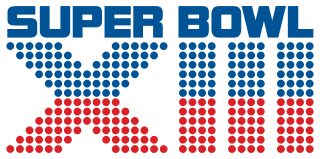
Super Bowl XIII was an American football game between the American Football Conference (AFC) champion Pittsburgh Steelers and the National Football Conference (NFC) champion Dallas Cowboys to decide the National Football League (NFL) champion for the 1978 season. The Steelers defeated the Cowboys by the score of 35–31. The game was played on January 21, 1979, at the Miami Orange Bowl in Miami, Florida, the fifth and last time that the Super Bowl was played in that stadium.
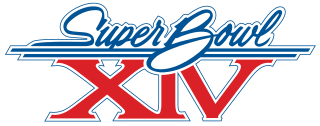
Super Bowl XIV was an American football game between the National Football Conference (NFC) champion Los Angeles Rams and the American Football Conference (AFC) champion Pittsburgh Steelers to decide the National Football League (NFL) champion for the 1979 season. The Steelers defeated the Rams by the score of 31–19, becoming the first team to win four Super Bowls. The game was played on January 20, 1980, at the Rose Bowl in Pasadena, California, and was attended by a Super Bowl record 103,985 spectators. It was also the first Super Bowl where the game was played in the home market of one of the participants, as Pasadena is 10 miles (16 km) northeast of Downtown Los Angeles.
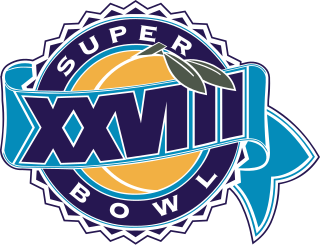
Super Bowl XXVIII was an American football game between the National Football Conference (NFC) champion Dallas Cowboys and the American Football Conference (AFC) champion Buffalo Bills to decide the National Football League (NFL) champion for the 1993 season. The Cowboys defeated the Bills, for the second straight year, by a score of 30–13, winning their fourth Super Bowl in team history, tying the Pittsburgh Steelers and the San Francisco 49ers for most Super Bowl wins. The Buffalo Bills became the only team to both play and lose four consecutive Super Bowls for a 0-4 franchise Super Bowl record, and as of 2023, remains the team's most recent Super Bowl appearance. The game was played on January 30, 1994, at the Georgia Dome in Atlanta. Since the 1993 regular season was conducted over 18 weeks, the traditional bye week between the conference championship games and the Super Bowl was not employed; the last time this had happened was before Super Bowl XXV.
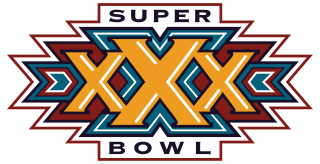
Super Bowl XXX was an American football game between the National Football Conference (NFC) champion Dallas Cowboys and the American Football Conference (AFC) champion Pittsburgh Steelers to decide the National Football League (NFL) champion for the 1995 season. The Cowboys defeated the Steelers by the score of 27–17, winning their fifth Super Bowl in team history. The game was played on January 28, 1996, at Sun Devil Stadium in Tempe, Arizona, the first time the Super Bowl was played in the Phoenix metropolitan area.
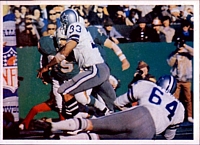
The National Football League playoffs for the 1971 season began on December 25, 1971. The postseason tournament concluded with the Dallas Cowboys defeating the Miami Dolphins in Super Bowl VI, 24–3, on January 16, 1972, at Tulane Stadium in New Orleans, Louisiana.

The National Football League playoffs for the 1972 season began on December 23, 1972. The postseason tournament concluded with the Miami Dolphins defeating the Washington Redskins in Super Bowl VII, 14–7, on January 14, 1973, at the Los Angeles Memorial Coliseum in Los Angeles, California, becoming the only NFL team to finish a championship season undefeated and untied.
The National Football League playoffs for the 1973 season began on December 22, 1973. The postseason tournament concluded with the Miami Dolphins defeating the Minnesota Vikings in Super Bowl VIII, 24–7, on January 13, 1974, at Rice Stadium in Houston, Texas.
The National Football League playoffs for the 1974 season began on December 21, 1974. The postseason tournament concluded with the Pittsburgh Steelers defeating the Minnesota Vikings in Super Bowl IX, 16–6, on January 12, 1975, at Tulane Stadium in New Orleans, Louisiana.
The National Football League playoffs for the 1975 season began on December 27, 1975. The postseason tournament concluded with the Pittsburgh Steelers defeating the Dallas Cowboys in Super Bowl X, 21–17, on January 18, 1976, at the Orange Bowl in Miami.
The National Football League playoffs for the 1976 season began on December 18, 1976. The postseason tournament concluded with the Oakland Raiders defeating the Minnesota Vikings in Super Bowl XI, 32–14, on January 9, 1977, at the Rose Bowl in Pasadena, California.

The National Football League playoffs for the 1977 season began on December 24, 1977. The postseason tournament concluded with the Dallas Cowboys defeating the Denver Broncos in Super Bowl XII, 27–10, on January 15, 1978, at the Louisiana Superdome in New Orleans, Louisiana.
The National Football League playoffs for the 1978 season began on December 24, 1978. The postseason tournament concluded with the Pittsburgh Steelers defeating the Dallas Cowboys in Super Bowl XIII, 35–31, on January 21, 1979, at the Orange Bowl in Miami.
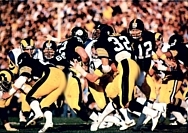
The National Football League playoffs for the 1979 season began on December 23, 1979. The postseason tournament concluded with the Pittsburgh Steelers defeating the Los Angeles Rams in Super Bowl XIV, 31–19, on January 20, 1980, at the Rose Bowl in Pasadena, California.
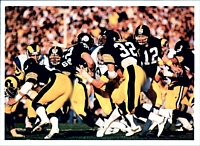
The 1979 season was the Los Angeles Rams' 42nd season in the National Football League (NFL), their 43rd overall, and their 34th in the Greater Los Angeles Area. It was the final season for the franchise in the Los Angeles Memorial Coliseum until 2016, as late owner Carroll Rosenbloom previously announced the Rams would move to Anaheim Stadium for the 1980 season.
The 1978 Dallas Cowboys season was their 19th in the National Football League (NFL). For the third consecutive season, the Cowboys finished in first place in the NFC East. The Cowboys scored 384 points, which ranked first in the league, while the defense only gave up 208 points, 3rd best in the league. Twice, the Cowboys appeared on Monday Night Football.
The 1977 Denver Broncos season was the team's 18th year in professional football and its eighth with the National Football League (NFL).
The 1975 AFC Championship Game was the sixth title game of the American Football Conference (AFC). Played on January 4, 1976, the game was hosted by the AFC Central champion and defending AFC and Super Bowl champion Pittsburgh Steelers who, in a rematch of the 1974 title game, played the AFC West champion Oakland Raiders at Three Rivers Stadium in Pittsburgh, Pennsylvania. Along with the 1975 NFC Championship Game played on the same day, this game constituted the penultimate round of the 1975-76 NFL playoffs which had followed the 1975 regular season of the National Football League (NFL).












